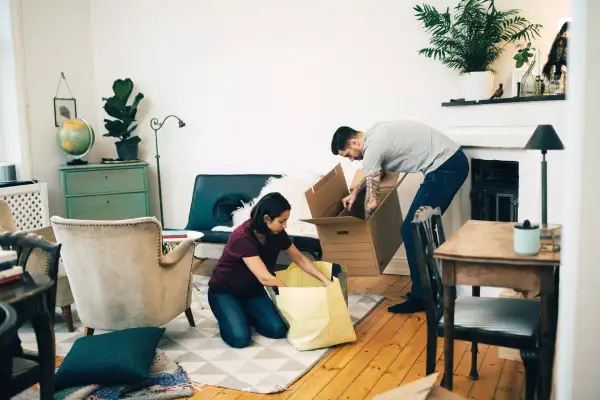Getting a New Home Move-in Ready Costs a Lot More Than You Think

You’ve been dreaming about this day for a long time. You beat out the competition in a fierce and cutthroat market and finally bought your first home. Now, you’re looking forward to moving in and setting up your house just the way you want it.
If you’re one of the lucky ones that got a house in perfect move-in condition, rejoice. For many, however, there’s still work to do and money to spend before you can finally enjoy your home.
How much money? The average home for sale right now needs $26,900 worth of work, according to a recent report from listing site Zillow and home repair marketplace Thumbtack. According to a survey released with the report, that’s about two to three times what most new homeowners expect to spend on getting their home move-in ready.
Costs can include projects as simple as fixing a leaky faucet and as complex as replacing faulty pipes.
What does move-in ready mean?
When people think of a move-in ready home, they envision a home where any urgent projects or repairs have already been taken care of, says Amanda Pendleton, home trends expert for Zillow. While the definition of “move-in ready” can vary between buyers, the home is basically safe, clean and functional.
You probably identified larger projects such as kitchen renovations or roof repairs when you toured the home or after speaking with a home inspector. Hopefully, you consider these things when making an offer and set a budget for them. Smaller or less obvious projects can also add up and swell your move-in expenses.
“If you’ve never purchased a home before it’s really hard to have a sense of what you should be looking for and what some of these projects can cost,” says Pendleton.
Here are four projects to get your home move-in ready and tips for keeping them cost effective:
Change or rekey the locks
Safety first. Unless you’re purchasing a newly-built home, you’ll want to rekey or change the locks on exterior doors. The previous owner likely handed in their keys, but you don’t know how many copies have been made for anyone from a dog walk to a cleaning service to the old owner’s family members or neighbors.
Rekeying means recalibrating the pins in the existing locks so that the old keys can’t open them. The average cost to rekey a lock is $350, according to Thumbtack.
Your other option is to change the locks on the home, which can cost between $80 and $200 per lock with a professional locksmith. Smart locks and some high end hardware could be more expensive. If you’re handy, you can buy new locks and install them yourself for a fraction of the cost.
Tip: Shop around for estimates. While some repairs you may be able to do yourself, others are better off left to professionals. To keep control over your costs, get an estimate from several different service providers to find the right person or company that can do the job.
You can find local service professionals in your area by accessing any number of home service marketplaces like Thumbtack, Angi or HomeGuide.
Get the HVAC serviced
One of the more commonly overlooked systems in your home is the heating, ventilation and air conditioning (HVAC) system. Unless you specifically ask, you don’t know how often or when the last maintenance visit took place.
Depending on the type of filter your system uses, it’ll need to be replaced either every 30 days or every six months. Older systems should be serviced every six months, while newer systems should be checked every year.
A full service includes inspecting and cleaning heating exchangers, coils, condensate pans, and the motor. Cooling systems need to be inspected for refrigerant leaks, damage to the ductwork and potential problems such as mold or bacteria in the system.
Regular air conditioning maintenance visits can average between $75 and $200, while a service contract that covers the whole HVAC system can range between $150 to $500 per year, according to home service site Angi.
If the HVAC system in your new home needs replacement, you can expect to pay an average of $3,615, according to the Zillow and Thumbtack report. Most experts recommend changing the HVAC unit after ten years of use, although regular maintenance can extend the life of the system.
Tip: Test everything. Turn on the air conditioner or heating system to make sure they are working properly. Ask about the service history and when the last maintenance or repair was done.
You also want to check that any appliances left in the home are in good condition. Check for obvious leaks in faucets and toilets, and test to see if the water heater is working. Check electrical outlets too.
Don’t overlook leaks or clogs
Making sure your plumbing system is in good shape will not only conserve water but also save money. Plumbing issues can be as simple as a leaky faucet or clogged drain or as serious as burst pipes or problems with the main sewer lines.
The cost to unclog a toilet or repair a leaky faucet can average between $125 to $300 Fixing a leaky pipe can cost as much $800, while a burst pipe can cost up to $1,500 to repair. Problems with the main sewer line are going to represent the most significant cost, with repairs averaging up to $3,700, according to home marketplace HomeGuide.
Tip: Don’t skip the home inspection. In today’s hot market some homebuyers are waving inspections to make their bids more attractive to sellers. This can be dangerous, because you could end up with a home with structural damage requiring costly repairs, says Pendleton.
A proper inspection can identify plumbing problems that aren’t visible to the naked eye, as well as point out other not so obvious areas that require attention and help you better plan and budget for repairs.
Repair the floors
You may have toured a house where rugs covered up part of the floor. The area you could see looked to be in good condition, so you may not have given it a second thought.
Now you're ready to move in and you see the carpeting may have been hiding scuff marks, dings or parts of the floor that may need some TLC.
Depending on the type of floor, repair costs can range between $315 and $1,245, according to the Zillow survey. If the floor needs to be replaced, costs can be $4,000 or more.
Tip: Walk through the home with your real estate agent. They have the experience to ask about the condition of flooring that lies under carpeting and can help identify other potential problem areas in a home. They’ll view the home with a critical eye, know what to look for and can point out items that you may miss.
More from Money
How to Get a Home Improvement Loan
Waiving Your Home Inspection? The Pros and Cons of Buying New 'Inspection Protection' Plans
Swimming Pools Are Making a Big Splash on the Housing Market This Summer

